
The Maxwell architecture has been a remarkable advancement for Nvidia. Partner GTX750Ti solutions have earned many awards at KitGuru due to a combination of minimal power drain, modest heat output and excellent frame rate performance at 1080p resolutions. Today is an important one for the company as they expand their Maxwell portfolio, releasing not one but two new models – the GTX970 and GTX980. We look at the reference GTX980 in this specific analysis.

There is no doubt that Nvidia can create exemplary, low noise reference coolers. Part of their success in the development of these reference coolers is related to their advancements in dealing with power demands and subsequent heat output. Make no mistake, the continued hunt for additional graphics performance does come with a caveat – rising power consumption.
Much of Nvidia's focus with the Maxwell architecture has been in dropping power and heat as far as they can – without compromising the performance of the hardware. AMD really do need to take note.
The Maxwell architecture has been designed to deliver twice the performance per watt of previous generation Geforce hardware. It sounds easy enough on paper, but the real world challenges for Nvidia have been complex.
| GPU | GeForce GTX 680 (Kepler) | GeForce GTX 980 (Maxwell) |
| Streaming Multiprocessors |
8 | 16 |
| CUDA Cores | 1536 | 2048 |
| Base Clock | 1006 mhz | 1126 mhz |
| GPU Boost Clock | 1058 mhz | 1216 mhz |
| TFLOPS (based on base clock) | 3.1 | 4.6 |
| TFLOPS (based on boost clock) | 3.3 | 5 |
| Texel fill-rate | 129 Gigatexels/Sec | 144.1 Gigatexels/Sec |
| Memory Clock | 6000 mhz | 7000 mhz |
| Memory Bandwidth | 192 GB/sec | 224 GB/sec |
| ROPs | 32 | 64 |
| Manufacturing Process | 28nm | 28nm |
| TDP | 195 watts | 165 watts |
The new GM204 GPU is very efficient. The Maxwell SM has been rebalanced so that the CUDA cores are fully utilised more often. Doing so saves power and enhances overall performance. The L2 cache size in the GM204 is 2MB, or four times larger than the GK104. The addition of extra cache means that fewer requests to the GPU memory are needed – again reducing power consumption and pushing more performance.
The Geforce GTX 980 is equipped with 7Gbps memory. Those of you with higher resolution monitors, or running in a multi screen configuration will also be pleased to hear that there is 4GB of GDDR5 memory on the card, not 3GB – this memory will push 224 GB/s sec. Nvidia have added a new compression engine to reduce the demand on DRAM bandwidth.

We received our sample direct from Nvidia and it arrived in a beautifully presented black box, with green stripe.

‘The World's Most Advanced GPU' is highlighted along the front of the box. No bundle with the review sample, but Nvidia partners will bundle various power, video adapters and literature with their cards.
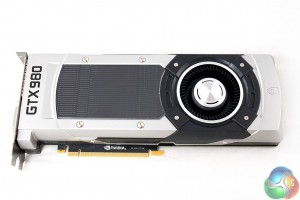

I have to admit, I do like the appearance of the Nvidia reference coolers. Its an industrial, modern design which looks great in any system build. The Geforce GTX980 measures 10.5 inches.

The ‘Geforce GTX' text will glow green when the card is powered on.

If you have been paying close attention, you will see that part of the backplate is a little higher than the rest – we have highlighted the area in red. This part is removable. Gamers with a single GTX980 or two in SLi with adequate spacing will not need to touch this.
Those running 3 way configurations or with two cards running directly side by side without an open slot between them can remove this part of the backplate. Why bother?

Nvidia claim this improves airflow over the PCB. They say that their engineering team spent time studying airflow between boards and came to the conclusion that this area is ‘critical for feeding air directly into the adjacent fan'.
Nvidia say that by removing this part of the backplate you will be effectively improving airflow between the cards when they are directly beside each other. We can't test this yet, as we only have one reference board in hand.


The Geforce GTX980 is SLi capable and it takes power from 2x 6 pin PCIe cables, shown above.

Nvidia have three DisplayPort connectors available on the I/O backplate, alongside an HDMI 2.0 capable connector. This HDMI port will handle 4K resolutions at up to 60hz. There is also a dual link DVI connector on the top row. Up to four of these output connectors can be used simultaneously.
Three G-SYNC displays can be driven from a single GTX 980.
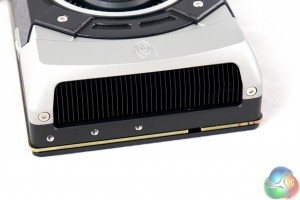
Cool air is driven in from one side of the card, then warm air expelled out the rear of the computer chassis.

Above, the rear of the PCB with the backplate removed.



Nvidia are using 4GB of high grade Samsung GDDR5 memory on the reference card. We cleaned the thermal paste from the GPU core and GM204 markings are shown as ‘GM204-400-A1'.
Nvidia have incorporated a 4 phase power supply with overvoltaging capability. This is given the task of feeding the GM204 GPU with power. An extra power phase is dedicated to delivering power to the GDDR5 memory.
The Geforce GTX980 runs at higher clock frequencies than any other reference Nvidia card before it. They have incorporated integrated dynamic power balancing circuitry to ensure the GPU gets the power delivery evenly across all three power sources (each 6 pin connector and the PCI e slot).
With the dynamic power balancing system in place, the card will direct power from each connector when needed. If one power source is at the limit, the card will draw power from the others to balance it out. This is a feature exclusive to the GTX 980 and GTX 780 Ti.

Special thanks to Mike over at Techpowerup for sending me over the latest beta version of GPUZ to fully support the Geforce GTX980. I felt like I was living in an episode of Back To The Future seeing a ‘release date' of 19th September, when I started working on this review around the 13th.
The GM204 GPU is manufactured on the 28nm process. There are 64 ROPS, 128 Texture units and 2,048 CUDA Cores. The core speed is clocked at 1,127mhz with a turbo boost to 1,216mhz. The 4GB of GDDR5 memory is clocked at 1,753mhz (7Gbps effective).
Overclocking and testing at ‘maximum performance‘
Our review today features the reference Nvidia Geforce GTX980 against a series of overclocked custom cooled cards from Nvidia and AMD partners.
As we are only reviewing a reference GTX980 today we felt it was worthwhile to get the overclocking out of the way first – and include additional results with the card overclocked to the limit throughout the rest of the review. This should give a better indication of performance you could expect from overclocked partner GTX980 solutions when they are released to market over the coming weeks.
To overclock the Nvidia GTX980 today, we used the latest version of MSI's Afterburner tool (Version 4.0.0), which is based on Rivatuner.


Nvidia partners are going to have a field day with the GTX980. There is clearly plenty of headroom available via the new Maxwell core. We managed to get almost 18 percent extra, hitting a stable peak at 1,329mhz with a couple of tweaks to the core voltage and Power limit settings. The Boost speed could be increased from the default speeds of 1,216 mhz to 1,418 mhz. This is a mighty overclock for a high end graphics card.
The memory exhibited a little headroom, but we left it at the default settings as it really doesn't affect the overall scores that much and partners don't tend to overclock memory much beyond the reference rated clock speeds anyway.
On this page we present some high resolution images of the product taken with a Fuji XT1 and a Sigma SD1 camera. These will take much longer to open due to the dimensions, especially on slower connections. If you use these pictures on another site or publication, please credit Kitguru.net as the owner/source.











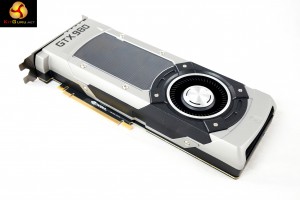




For the review today we are using the latest Nvidia Forceware 344.07 and AMD Catalyst 14.7 beta drivers. All of the AMD and Nvidia hardware in our reviews today used these drivers – tested this week before launch.

We are using one of our brand new test rigs supplied by DINOPC and built to our specifications. If you want to read more about this, or are interested in buying the same Kitguru Test Rig, check out our article with links on this page. We are using an Asus PB287Q 4k and Apple 30 inch Cinema HD monitor for this review today.
Comparison cards:






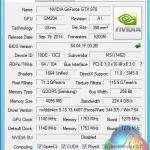
Asus GTX780 Ti Direct CU II OC (954mhz core / 1750 mhz memory)
Sapphire R9 290X Tri-X OC (1040 mhz core / 1300 mhz memory)
MSI GTX970 Gaming 4G (1140 mhz core / 1753 mhz memory)
Palit GTX780 6GB (902 mhz core / 1502mhz memory)
Asus GTX970 StriX OC (1114 mhz core / 1753 mhz memory)
Asus R9 290 Direct CU II OC (1000 mhz core / 1260 mhz memory)
Software:
Windows 7 Enterprise 64 bit
Unigine Heaven Benchmark
Unigine Valley Benchmark
3DMark Vantage
3DMark 11
3DMark
Fraps Professional
Steam Client
FurMark
Games:
Grid AutoSport
Tomb Raider
Metro Last Light Redux
Thief 2014
All the latest BIOS updates and drivers are used during testing. We perform generally under real world conditions, meaning KitGuru tests games across five closely matched runs and then average out the results to get an accurate median figure. If we use scripted benchmarks, they are mentioned on the relevant page.
Game descriptions edited with courtesy from Wikipedia.
Futuremark released 3DMark Vantage, on April 28, 2008. It is a benchmark based upon DirectX 10, and therefore will only run under Windows Vista (Service Pack 1 is stated as a requirement) and Windows 7. This is the first edition where the feature-restricted, free of charge version could not be used any number of times. 1280×1024 resolution was used with performance settings.



The Nvidia GTX980 at reference clock speeds is slightly outperformed in this older Direct X 10 benchmark by the overclocked GTX780 ti. When we overclock the GTX980 to 1,329mhz it moves way out in front – a good indication of what is possible when Nvidia partners release their custom overclocked solutions.
3DMark 11 is designed for testing DirectX 11 hardware running on Windows 7 and Windows Vista the benchmark includes six all new benchmark tests that make extensive use of all the new features in DirectX 11 including tessellation, compute shaders and multi-threading. After running the tests 3DMark gives your system a score with larger numbers indicating better performance. Trusted by gamers worldwide to give accurate and unbiased results, 3DMark 11 is the best way to test DirectX 11 under game-like loads.
If you want to learn more about this benchmark, or to buy it yourself, head over to this page.



The Nvidia GTX980 takes top position in this newer Direct X 11 benchmark, even at reference clock speeds. When overclocked it moves into a new performance zone way ahead of the other solutions on test today.
3DMark is an essential tool used by millions of gamers, hundreds of hardware review sites and many of the world’s leading manufacturers to measure PC gaming performance.
Futuremark say “Use it to test your PC’s limits and measure the impact of overclocking and tweaking your system. Search our massive results database and see how your PC compares or just admire the graphics and wonder why all PC games don’t look this good.
To get more out of your PC, put 3DMark in your PC.”

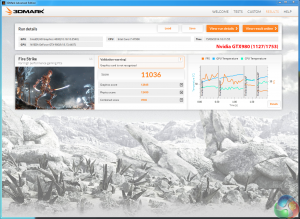

The latest 3DMark indicates the GTX980 is the clear performance leader above overclocked R9 290x and GTX780Ti's solutions – even when it is at reference clock speeds. When overclocked to the redline, it is almost 2,500 points ahead of the Asus GTX780 Ti Direct CU II OC edition.
Unigine provides an interesting way to test hardware. It can be easily adapted to various projects due to its elaborated software design and flexible toolset.
A lot of their customers claim that they have never seen such extremely-effective code, which is so easy to understand.
Heaven Benchmark is a DirectX 11 GPU benchmark based on advanced Unigine engine from Unigine Corp. It reveals the enchanting magic of floating islands with a tiny village hidden in the cloudy skies. Interactive mode provides emerging experience of exploring the intricate world of steampunk.
Efficient and well-architected framework makes Unigine highly scalable:
- Multiple API (DirectX 9 / DirectX 10 / DirectX 11 / OpenGL) render
- Cross-platform: MS Windows (XP, Vista, Windows 7) / Linux
- Full support of 32bit and 64bit systems
- Multicore CPU support
- Little / big endian support (ready for game consoles)
- Powerful C++ API
- Comprehensive performance profiling system
- Flexible XML-based data structures

We set Quality to ‘High', Tessellation to ‘Normal' and resolution to 1600p.



At reference clock speeds the GTX980 is slightly outperformed by the overclocked Asus GTX780 Ti. When we overclock the GTX980 to 1,329mhz it manages to easily outperform the overclocked GTX780 Ti however.
Valley Benchmark is a new GPU stress-testing tool from the developers of the very popular and highly acclaimed Heaven Benchmark. The forest-covered valley surrounded by vast mountains amazes with its scale from a bird’s-eye view and is extremely detailed down to every leaf and flower petal. This non-synthetic benchmark powered by the state-of-the art UNIGINE Engine showcases a comprehensive set of cutting-edge graphics technologies with a dynamic environment and fully interactive modes available to the end user.

We toggle quality to HIGH, and resolution to 1600p.



The reference clocked GTX980 performs well out of the box, falling in slightly behind the overclocked Asus GTX780 Ti Direct CU II solution. The story is different when we overclock the GTX980 to give a better indication of upcoming custom partner solutions – it claims top spot in the chart.
Grid Autosport (styled as GRID Autosport) is a racing video game by Codemasters and is the sequel to 2008′s Race Driver: Grid and 2013′s Grid 2. The game was released for Microsoft Windows, PlayStation 3 and Xbox 360 on June 24, 2014. (Wikipedia).



On this page we test at 1080p and 1600p using the ‘Ultra' image quality profile with 8x MSAA.


The Nvidia GTX980 holds the top position with this game engine, having no problems whatsoever holding 75fps+ at 1600p. The overclocked Asus GTX780 Ti takes up the position directly behind the new GTX980.
Grid Autosport (styled as GRID Autosport) is a racing video game by Codemasters and is the sequel to 2008′s Race Driver: Grid and 2013′s Grid 2. The game was released for Microsoft Windows, PlayStation 3 and Xbox 360 on June 24, 2014. (Wikipedia).

We test at Ultra HD 4k with 8MSAA. The Ultra Profile is selected for maximum image quality.

Interesting to see that the Sapphire R9 290X Tri-X OC claims a few positions in the chart at 4k resolution, falling in just behind the Asus GTX780 Ti Direct CU II OC. The Nvidia GTX980 takes top position in the chart even at the reference clock speeds out of the box.
Thief is set in a dark fantasy world inspired by Victorian, gothic, and steampunk aesthetics. Garrett, a master thief who has been away from his hometown for a long time, returns to it, a place known only as The City, and finds it ruled with an iron grip by a tyrant called The Baron. While The City is ravaged by a plague, the rich continue to live in isolation and good fortune while the poor are forming numerous mobs against the authorities, Garrett intends to use the volatile situation to his favor. (Wikipedia).


We test with the ‘very high' image quality preset at 1080p and 1600p.


Thief looks great on the latest Nvidia hardware – and the GTX980 claims the top spot by a clear margin. When manually overclocked the card delivers a little extra performance.
Thief is set in a dark fantasy world inspired by Victorian, gothic, and steampunk aesthetics. Garrett, a master thief who has been away from his hometown for a long time, returns to it, a place known only as The City, and finds it ruled with an iron grip by a tyrant called The Baron. While The City is ravaged by a plague, the rich continue to live in isolation and good fortune while the poor are forming numerous mobs against the authorities, Garrett intends to use the volatile situation to his favor. (Wikipedia).

We test at the ‘very high' preset for maximum image quality. Resolution is set to 4k for this particular test.

At this insane resolution the Thief engine proves unplayable on all but one solution. The Nvidia GTX980 when overclocked to 1,329mhz managed to maintain smooth frame rates holding above 25fps at all times. At 4k, the Sapphire R9 290X Tri-X OC moves up the list a little, in behind the Asus GTX780Ti Direct CU II OC Edition.
Tomb Raider received much acclaim from critics, who praised the graphics, the gameplay and Camilla Luddington’s performance as Lara with many critics agreeing that the game is a solid and much needed reboot of the franchise. Much criticism went to the addition of the multiplayer which many felt was unnecessary. Tomb Raider went on to sell one million copies in forty-eight hours of its release, and has sold 3.4 million copies worldwide so far. (Wikipedia).



We test with the ‘ultimate' image quality profile at 1080p and 1600p.


Top positions are held by the GTX780ti and GTX980 cards, way out in front of the rest.
Tomb Raider received much acclaim from critics, who praised the graphics, the gameplay and Camilla Luddington’s performance as Lara with many critics agreeing that the game is a solid and much needed reboot of the franchise. Much criticism went to the addition of the multiplayer which many felt was unnecessary. Tomb Raider went on to sell one million copies in forty-eight hours of its release, and has sold 3.4 million copies worldwide so far. (Wikipedia).


We test at Ultra HD 4k resolution with the ‘Ultra' image profile enabled. Single GPU solutions find the ‘Ultimate' image quality preset too difficult to power properly.

Interesting to see the Asus GTX780 TI Direct CU II OC solution scores so well at 4K, ahead of the reference clocked GTX980.
On May 22, 2014, a Redux version of Metro Last Light was announced. It was released on August 26, 2014 in North America and August 29, 2014 in Europe for the PC, PlayStation 4 and Xbox One. Redux adds all the DLC and graphical improvements. A compilation package, titled Metro Redux, was released at the same time which includes Last Light and 2033. (Wikipedia).
We test with following settings: Quality-Very High, SSAA-off, Texture Filtering-16x, Motion Blur-Normal, Tessellation-Normal, Advanced Physx-On.


The new Nvidia GTX980 storms the top of the charts, especially when overclocked to 1,329mhz. At reference speeds however, the card manages to outperform the overclocked Asus GTX780 TI Direct CU II OC.On May 22, 2014, a Redux version of Metro Last Light was announced. It was released on August 26, 2014 in North America and August 29, 2014 in Europe for the PC, PlayStation 4 and Xbox One. Redux adds all the DLC and graphical improvements. A compilation package, titled Metro Redux, was released at the same time which includes Last Light and 2033. (Wikipedia).
We test with following settings: Quality-High, SSAA-off, Texture Filtering-16x, Motion Blur-off, Tessellation-Normal, Advanced Physx-off.

No change in the positions when we move from 1080p and 1600p resolutions. At 4K, the GTX980 holds the top performance positions.The tests were performed in a controlled air conditioned room with temperatures maintained at a constant 23c – a comfortable environment for the majority of people reading this.Idle temperatures were measured after sitting at the desktop for 30 minutes. Load measurements were acquired by playing Crysis Warhead for 30 minutes and measuring the peak temperature. We also have included Furmark results, recording maximum temperatures throughout a 30 minute stress test. All fan settings were left on automatic.


The reference cooler copes well when gaming, peaking around 73c. When loaded with Furmark this rises to 80c. Furmark isn't a realistic real world test, but we like to include it as a theoretical worst case scenario.
We have built a system inside a Lian Li chassis with no case fans and have used a fanless cooler on our CPU. The motherboard is also passively cooled. This gives us a build with almost completely passive cooling and it means we can measure noise of just the graphics card inside the system when we run looped 3dMark tests.
We measure from a distance of around 1 meter from the closed chassis and 4 foot from the ground to mirror a real world situation. Ambient noise in the room measures close to the limits of our sound meter at 28dBa.
Why do this? Well this means we can eliminate secondary noise pollution in the test room and concentrate on only the video card. It also brings us slightly closer to industry standards, such as DIN 45635.
KitGuru noise guide
10dBA – Normal Breathing/Rustling Leaves
20-25dBA – Whisper
30dBA – High Quality Computer fan
40dBA – A Bubbling Brook, or a Refridgerator
50dBA – Normal Conversation
60dBA – Laughter
70dBA – Vacuum Cleaner or Hairdryer
80dBA – City Traffic or a Garbage Disposal
90dBA – Motorcycle or Lawnmower
100dBA – MP3 player at maximum output
110dBA – Orchestra
120dBA – Front row rock concert/Jet Engine
130dBA – Threshold of Pain
140dBA – Military Jet takeoff/Gunshot (close range)
160dBA – Instant Perforation of eardrum
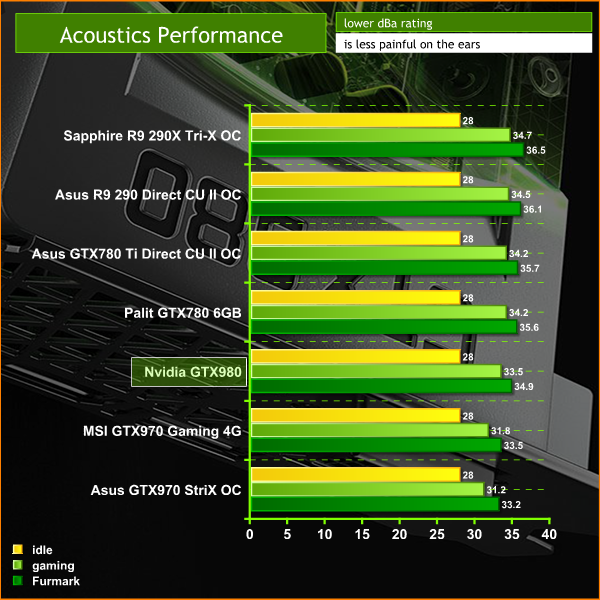
Nvidia have made great reference coolers for years, and the cooler on the GTX980 is more than up to the job. Any noise from the GTX980 will likely be masked out by a couple of chassis fans. The Maxwell architecture certainly helps Nvidia when it comes to fan activity – when idle, the fan is spinning at 1,000 rpm. Under gaming load, this rises to around 1,700 rpm and under Furmark load, it rises to 2,100 rpm.
To test power consumption today we are using a Keithley Integra unit and we measure power consumption from the VGA card inputs, not the system wide drain. We measure results while gaming in Tomb Raider at 4k resolution and the synthetic stress test Furmark – recording both results.

The Maxwell architecture is extremely power efficient – seen before with the excellent GTX750 ti, which took all the power it needed from the PCI e slot.
The Nvidia reference GTX980 demands 158 watts total when gaming – when this is directly compared to the R9 290/X (225/237 watts respectively) you can see how far ahead Nvidia are in this regard.
When I first analysed Nvidia's GTX750ti back in March I was supremely impressed with the Maxwell architecture. This was a card that when overclocked could keep up with AMD's HD7850. When you realised it was consuming half the power at the socket and didn't even need an external PCI e connector it was difficult not to appreciate how far Nvidia had moved the goalposts.
I said at the time that I was excited to see how Nvidia would incorporate the Maxwell architecture into higher end models at a later date … and here we are today.
Nvidia's GTX980 is one of the most exciting high end solutions I have tested for a launch day event. AMD have been struggling with power consumption and heat for a long time now and Nvidia have managed to maintain GTX780ti performance while reducing power consumption to less than 160 watts when playing the latest Direct X 11 games.
Sure, some of you may balk at the mention of power consumption- who cares if its consuming less watts? We all should, because remember – this reduction in heat means cooler running graphics cards, slower running fans and the potential for gargantuan overclocking headroom. You will also save some money with an electricity bill over the course of a year, but that is a discussion for another day.
The Geforce GTX980 runs at higher clock frequencies than any other reference Nvidia card, however this is only the tip of the iceberg. Our sample was able to reach boost core speeds of 1,418mhz … from 1,216mhz. There is certainly immense potential for water cooling and LN2 lovers.
At reference clock speeds the GTX980 is very closely matched against the overclocked Asus GTX780Ti Direct CU II OC which we included in our review today. The GTX980 in our testing has a slight performance edge most of the time – while demanding 30% less power to do so. Those who have complained about the GTX780Ti having only 3GB of memory will be pleased that the GTX980 now has 4GB – useful when dealing with heavy texture based titles across multiple screens or at 4k resolution.
When overclocked to 1,400mhz+ performance levels increase dramatically. This is the first single GPU graphics card that has scored 20,000 points in the graphics test of 3dmark11.
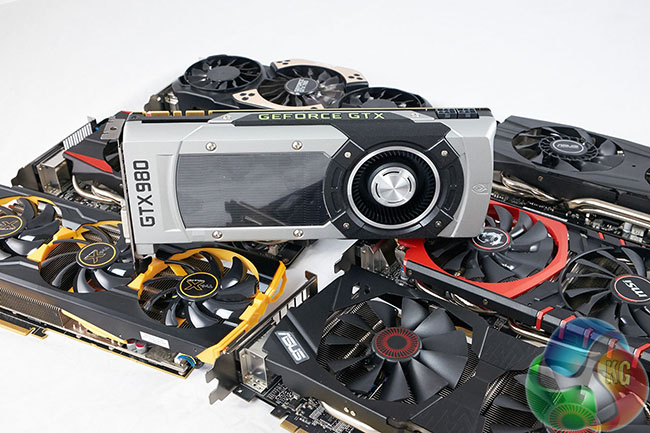
Nvidia told us before launch this week that they plan on releasing the reference GTX980 at £429.99 inc vat to the UK market. This is almost £100 less than a reference GTX780ti available on Amazon this week. Nvidia are clearly planning on phasing out the GTX780Ti over the coming months because we honestly see no reason to buy the older model anymore.
We would expect Nvidia partners to start releasing custom cooled, overclocked GTX980 in the coming weeks, with a slight premium – perhaps in the £460-£480 sector. At the price, AMD really have nothing to compete against the GTX980, especially when you factor in the performance to watt ratio. It will be interesting to see how AMD answer the release of the new Maxwell cards – we would expect to see big price drops over the coming months because until they release new architecture there is little else they can do.
There is no doubt right now, if I was buying a high end graphics card myself and had £450 to spare, the GTX980 would be right at the top of the list. Also, let us not forget the GTX970 which has also been released today – this is a solution you won't want to miss, especially at the incredibly competitive price point – check out our front page for more reviews on this one.
Discuss on our Facebook page, over HERE.
Pros:
- power efficiency is unmatched in the high end.
- 4GB GDDR5 memory.
- masses of overclocking headroom.
- quiet.
- Nvidia reference cards look great.
- class leading performance at the price.
- launch price of £429.99, £100+ less than many GTX780Ti prices.
Cons:
- You would still need two of them for high frame rates at 4K resolutions.
Kitguru says: Nvidia are breaking new ground with their Maxwell architecture. We applaud them for addressing heat and power consumption while still delivering class leading performance – at a new all time low price point. Expect AMD price reductions over the coming weeks.

 KitGuru KitGuru.net – Tech News | Hardware News | Hardware Reviews | IOS | Mobile | Gaming | Graphics Cards
KitGuru KitGuru.net – Tech News | Hardware News | Hardware Reviews | IOS | Mobile | Gaming | Graphics Cards



I’m not too excited about this gen.. I was expecting alot more from maxwell. Either way I will own the card when it comes out. I would like to see what the card actually performs like myself and see if the new features can bring it to Amd’s IQ level..
Waiting for the Next Gen Volta
How is this card running cool? Look at the reported temps it is the hottest of all tested. Across all reviews it averages roughly 73-75 degrees gaming and higher under extreme loads. If you were to overclock it, it would be extremely hot, reference r9 290x hot, way too hot!
And you haven’t taken fan speed into consideration. Turning the fan up to 100% on a reference high end GTX is still very much bearable in terms of noise. Extra fan noise for extra performance and stable temps. That’s how it always goes. Unlike the 290x that was a searing, red hot 95c at STOCK and ridiculously loud fans from AMD’s shitty reference design. If you want to keep those overclocks quiet then you buy an third party design. No one should ever intend to run a reference card overclocked off its balls anyway. Stop whining.
In sli the top card will be at the 90+ degree mark, no overclock. Just look at the numbers. Fan speed will not correct this. The really interesting card in all of this is the 970. I think it represents a revolution in price/performance, while the 980 cards are overkill for low res and just as incapable as all the others at multi display and/or 4K resolutions. The 20nm or sub 20nm cards are only a year or so away. As for stop whining, are you emotionally invested in a simple bit of conjecture? Its ok to have an opinion without espousing childishness.
Now you can read the most recent owner reviews on newegg and see how true my comments were in actual practice. This is not a jab. It is just a continuance of a prior conversation. Please do not get upset.
http://www.newegg.ca/Product/Product.aspx?Item=N82E16814487068&SortField=0&SummaryType=0&PageSize=10&SelectedRating=-1&VideoOnlyMark=False&IsFeedbackTab=true#scrollFullInfo